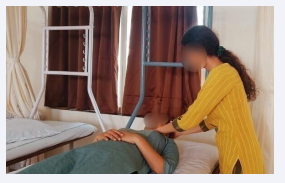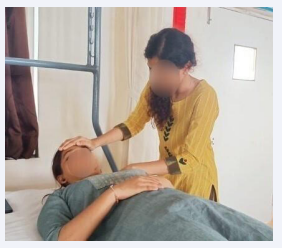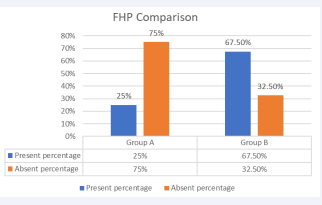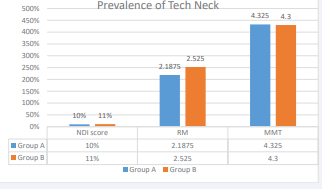Prevalence of Tech Neck in Adults-A Survey
- 1. Final year BPTh Student, Dr. APJ Abdul Kalam College of Physiotherapy, PIMS (DU), Ahmednagar, Maharashtra, India
- 2. Associate Professor, PhD Scholar, Dr. APJ Abdul Kalam College of Physiotherapy, Ahmednagar, Maharashtra, India
Abstract
Introduction: The widespread use of devices like mobile phones, laptops, and tablets has surged, especially after the COVID-19 pandemic shifted classes and meetings online. When people tilt their heads forward to look at these screens, the neck muscles bear increasing loads. At a 15-degree tilt, it’s around 12kg of force, rising to 27 kg at a 60-degree tilt [1]. This is because the muscles have to work harder to support the shifting center of gravity, leading to neck pain.
Objective: The objective of this study is to identify the pain and deformity in neck between two age groups, Young Adults (aged 17-30) and Adults (aged 31-59).
Procedure: 80 participants were randomly chosen and categorized into two groups based on their age. They were administered a self-completion questionnaire, specifically the Neck Disability Index, followed by an evaluation of their posture using the Ruler Method. Subsequently, their Cervical Muscle Strength was measured using Manual Muscle Testing (MMT) and graded according to the Oxford grading system.
Results and Discussion: The research conducted statistical analysis using an unpaired ’t’ test. The study findings indicate that Group B experiences a higher prevalence of Forward Head Posture (67.5%, mean score 2.53) compared to Group A, where the impact is lower (25%, mean score 2.19). Moreover, the Neck Disability Index (NDI) scores were higher in Group B than in Group A, while the Manual Muscle Testing (MMT) grades for cervical muscles were quite similar between the two groups, with Group A scoring 4.33 and Group B scoring 4.3, albeit with a slight strength difference in favor of Group A.
Keywords
• Smart Phones
• Screen
• Neck Disability
• Pain
• Digital Devices
INTRODUCTION
Mobile devices have evolved into not only the primary digital interface but also a bridge to the physical world. In contemporary times, children are introduced to smartphones at a very early age, typically between 3 to 5 years. This early exposure may have adverse implications for their posture, potentially placing excessive strain on their cervical musculature, giving rise to what is commonly known as “Tech Neck.” Tech Neck is a condition characterized by neck pain and discomfort resulting from prolonged and frequent downward gaze at mobile phones, tablets, and other digital devices, leading to various uncomfortable head positions [1,2]. Contrastingly, “Text Neck” is a behaviour associated with texting on smartphones while maintaining a flexed neck position. It is noteworthy that, despite different definitions, there is currently no scientific evidence establishing a direct link between Text Neck and neck pain. Consequently, it is advisable to refrain from using descriptors such as “inappropriate” or “incorrect” when characterizing posture [3]. When individuals engage in activities such as texting on a phone or working on a laptop, they consistently maintain a flexed neck position for extended durations. This posture places an increased load on the neck, subsequently heightening the demand on neck muscles. Tech Neck predominantly affects the posterior aspect of the neck, involving cervical vertebrae, cervical musculature, and spinal nerves.
Within the cervical region, the first two vertebrae, namely the atlas and axis, along with their associated muscles, are specifically adapted to provide support and position the head. Movements such as head flexion and extension (nodding motion) are facilitated by the first Cervical Vertebra (C1), while head rotation occurs as C1 articulates with C2 [4]. The utilization of smartphones in a more significantly flexed neck posture imposes a greater biomechanical burden on kinematics, gravitational forces, and neck muscle loading. This elevated load may elevate the risk of neck musculoskeletal discomfort and injuries. Conversely, maintaining a neutral neck posture minimizes these biomechanical factors [5]. When a person looks straight ahead, the weight of his head is around 4.5kg. Tilting the head forward to 15 degrees places about 12kg of force on the neck. This increases to 18kg at 30 degrees, 22kg at 45 degrees and 27kg at 60 degrees [1]. To further complicate matters, disparities in postural adjustments and muscle strength between young adults and individuals in their fourth decade may signify a generational gap resulting from the ever-evolving technological landscape, which has been notably transforming since the 1980s. The advent of mobile phones in India in 1995 marked the initiation of a technological revolution, spawning innovations such as various gaming consoles, laptops, and mobile devices. The user base for these technologies has substantially increased over the past two decades, possibly resulting in postural deformities, discomfort, and diminished muscle strength. This paper sets out to address this research gap.
Notably, a study conducted in 2020 estimated that the number of smartphone users in India had surpassed 748 million, and this number has continued to surge [6]. Moreover, alongside smartphones, various gaming platforms, including PlayStation and Xbox, are particularly popular among teenagers and pre teens. However, even adults frequently spend extended periods using laptops, often exceeding 7 to 8 hours. Consequently, these habits are likely to contribute to postural anomalies, discomfort, and reductions in muscle strength.
An investigation focusing on the awareness of Text Neck syndrome and its associated hazards found that 35% of the population had heard of Text Neck syndrome, with only 8% possessing knowledge about it. Furthermore, the results indicated that 21% of the population were aware of preventive measures for this syndrome [7]. Given the limited available literature on individuals suffering from Tech Neck, there is a critical need to ascertain the prevalence of Tech Neck, especially among young adults.
Existing studies have identified several neck muscles that can be affected by Text Neck, including the Cervical Erector Spinae (CES), upper trapezius [8], thumb and finger extensors [9], wrist extensors, shoulder medial rotators, and even orbicularis oculi. Moreover, this condition has broader implications, extending to the overall posture of the body, potentially leading to upper back kyphosis and forward head posture, characterized by hyper kyphosis of the cervical spine.
The central research question to address is the prevalence of Tech Neck in adults. Additional research objectives encompass assessing neck pain using the Neck Disability Index, evaluating cervical muscle strength via Manual Muscle Testing (MMT), and analysing neck posture in two different generations, specifically young adults and adults, employing the ruler measurement method.
MATERIAL AND METHODOLOGY
Prior to the commencement of this research, the subject matter received approval from the Institutional Ethics Committee (IEC). This study is characterized as an observational comparative investigation involving a total of 80 volunteers, spanning the age range of 14 to 59. The participants were selected through a convenient sampling method and categorized into two distinct groups based on their age. Group A comprised individuals aged 31 to 59, representing the “Adults” group, while Group B consisted of participants aged 17 to 30, representing the “Young Adults” group. The selection criteria for participation were a minimum screen time of 4 hours on any technical device, with individuals having a history of recent spinal trauma, surgery, or spinal deformities being excluded.
Prior to the study’s initiation, comprehensive information regarding the study’s procedures, contraindications for observation, the rationale for each test, and the consent process was thoroughly conveyed to the participants. The assessment of neck disability was carried out by means of the Neck Disability Index, which the participants completed. Subsequently, the participants’ postures were evaluated using the ruler method [10]. This involved instructing participants to stand with their backs against a wall, their feet positioned at a distance of 6 inches, with their sacrum and scapula in contact with the wall. The distance between the head and the wall was then measured.
Subsequent to the posture assessment, the muscle strength of the participants was appraised through Manual Muscle Testing specifically for cervical muscles [11]. The procedure began with participants lying supine on a bed, their arms positioned at their sides. Participants were instructed on how to execute cervical flexion and then asked to perform this motion independently by bringing their chin toward their chest. Resistance was applied by one hand on the participant’s forehead for stability, while the other hand was placed on their chest. Initially, moderate resistance was administered, and if the participant was able to perform the motion throughout the available range without difficulty, maximum resistance was subsequently applied. The grades were assigned in accordance with the Oxford grading system (Figure 1,2).
Figure 1: Teaching subject how to perform neck flexion.
Figure 2: Giving resistance to neck flexion.
DISCUSSION
Demographics
A total of 80 participants were observed after selection in accordance with the Inclusion and Exclusion criteria.
They were divided into two groups according to their age group
Group A- Adults (Participants aged 31-59),
Group B- Young Adults (Participants aged 17-30),
Age- The average age of group A is 44.1 years.
The average age of group B is 22.1 years.
Comparison between the two age groups for neck pain
This was measured using the Neck Disability Index. The mean of Group A (adults) was 10% ± 0.089583 and mean of Group B (young adults) was 11% ± 0.089262. The comparison was calculated using unpaired ‘t’ test and it shows that the study is significant with ‘t’ value 7.14 and p value 0.0001 (Table 1).
Comparison between two age groups for posture
This was measured using the Ruler method. The mean distance from the wall for Group A (adults) was 2.19 ± 0.5958 and that for Group B was 2.525 ± 0.5305. The comparison was calculated using unpaired ‘t’ test and it shows that the study is highly significant with ‘t’ value 3.81 and p value 0.0001. Out of 40 participants from Group A, forward head posture was only present in 25% of the participants, while 75% did not exhibit forward head posture. Whereas, from Group B, out of 40 participants, forward head posture was present in 67.5% of the participants, while only 32.5% participants did not exhibit forward head posture (Figure 3,4), (Table 2).
Figure 3: FHP comparison.
Figure 4: Comparison of prevalence of tech neck between the two age groups in NDI Score, ruler measurement (in cms) and MMT grading.
Comparison between two age groups for muscle strength
This was measured by Manual Muscle Testing (MMT) and graded according to the Oxford method of grading. The mean of Group A was 4.33 ± 0.694 and mean of Group B was 4.3 ± 0.7232. The comparison was calculated by unpaired ‘t’ test and it shows that the study was not significant with ‘t’ value 0.23 and p value 0.1126 (Table 3).
FINDINGS
In the current study, 80 subjects were categorized into two age-based groups: Group A (n = 40) composed of adults aged 31 59, and Group B (n = 40) consisted of young adults aged 17-30. These groups were established to assess neck pain, neck posture, and cervical muscle strength. The results indicate a significant difference in posture deviation between Group A and Group B. A study by Bhavna Anand and Sara Nishat in 2021 revealed a 28.17% prevalence of neck disability due to text neck syndrome in the 18-45 age group using the NDI scale. Upper extremity discomfort, measured by the upper extremity functional index -15 scores, was found to be 24.35%, with the most affected age group being 20-21 years [12].
Another study by Faeze Sarraf and Sakineh Varmazyar in 2022 demonstrated that head and neck tilt angles, along with forward head posture, varied in sitting positions with and without a backrest. The gaze angle was influenced, with the most strain observed when using a smartphone without a supportive surface while sitting or standing [13]..Notably, research indicates that cervical musculature in children differs from that in adults. Several factors contribute to the increased vulnerability of the cervical spine in children, including weaker cervical ligaments and paraspinal muscles, greater water content in intervertebral disks, unfused epiphyses, and other anatomical features, making the young adult spine more susceptible to deformation and postural changes [14]. This might be the reason that the spine of young adults was easily deformed and lead to postural changes.
CONCLUSIONS
The growing use of digital devices underscores the importance of raising awareness about the adverse effects of improper device angles. Employing ergonomic devices to optimize screen angles can help alleviate neck strain. A conducted study has reported significant improvements in movement velocity and acceleration during active neck movements in all directions following ergometer interventions [15]. Physiotherapists have the option to employ manual therapy techniques like myofascial release, trigger point therapy, cervical spine mobilizations, manipulations, and dry needling to alleviate neck pain [16]. In addition, relaxation techniques such as breathing exercises, meditation, yoga, and Cognitive Behavioural Therapy (CBT) have proven effective in reducing symptoms of stress, anxiety, and depression, which are common contributors to neck pain [16]. Furthermore, designing workstations with proper support and alignment is crucial to promote individual well-being [17,18].
• Feet must be supported.
• Knees bent at 90 degrees and thighs parallel to the floor.
• Lumbar support must be provided to maintain the natural curvature of the spine.
• Elbows should be supported on the armrests or desk.
• The monitor has to be at about arm-length distance and at eye-level or slightly lower.
• The individual shouldn’t have to rotate the body to reach the computer or desk.
• Sufficient leg space is also important.
A significant challenge in office or desk work is the prolonged periods of physical inactivity. This leads to reduced blood circulation, exhaustion of postural muscles, and heightened muscle tightness. Research endorses the incorporation of microbreaks, suggesting that brief, active breaks every 20 minutes are ideal. These microbreaks enhance comfort, alleviate pain, and boost productivity [19].
APPENDIX
Neck Disability index is a self-completion questionnaire, which comprises of 20 questions related neck pain and disability while performing ADLs [20].
REFERENCES
4. Drake RL, Vogl AW, Mitchell AWM. Gray’s Anatomy for Students 4th (Edn.) 2019.
6. Sun S. Smartphone users in India 2010-2040. 2021.
10. G Morrison. How to Measure and Fix Forward Head Posture. 2019.
11. Hislop HJ, Montgomery J. Daniels and Worthingham’s Muscle Testing: Techniques of Manual Examination. 6th (Edn.), WB Saunders, Philadelphia. 1995.












































































































































